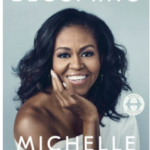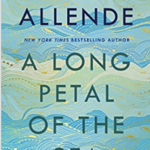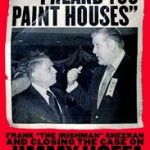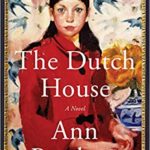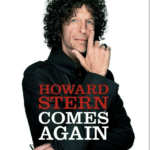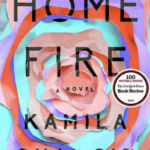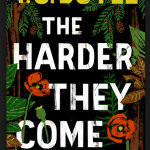December 16th, 2013 — 11:44am
 Serena by Ron Rash– In a recent book review of the best seller Gone Girl , I noted that despite that book being a very exciting mystery, there was a paucity of information about the background and psychological make up of the two protagonists. Similarly, Serena offers us two very strong characters, Serena and her husband Pemberton, with an interesting but certainly not a page turning, edge of your seat mystery. There is no significant in-depth backstory that really allows us to understand the characters and why they are who they are and how they got there. This certainly does not have to be the mission of every novel but without it we have to evaluate what have we been given? In this case it is an insight into the lives of the mostly men and some women who cut, sawed and hacked their way across the Appalachian mountains of North Carolina, Tennessee and surrounding areas in the late 1920s and early 30s’ while the country was in a depression. We came to appreciate the hardship and, at times, danger to life and limb that these lumbermen experienced. We get a glimpse at the movement to develop a national park system and the conflict with the entrepreneurs who were buying up the land to take the trees and minerals while essentially leaving it bare. We also meet a unique married couple who are not only the bosses of a company that is engaged in these practices but who also embody a mean spirited perhaps “evil” nature. They will think nothing of endangering their workers, manipulating and lying to potential business partners and doing whatever has to be done to achieve their ends. This includes a willingness to murder anyone. Thus the book in one sense is a morality play with the workers talking among themselves acting like a Greek chorus highlighting the code of ethics or rather lack of them which are being acted out. Serena, herself emerges as a person who burnt her bridges behind her (although we don’t quite really understand what they were made of) and would do anything to be the timber baroness of the US and then of Brazil. Her singlemindedness becomes frightening and is made of the stuff that would make her an ideal role for any great actress to undertake when Serena , the movie,is ultimately made.
Serena by Ron Rash– In a recent book review of the best seller Gone Girl , I noted that despite that book being a very exciting mystery, there was a paucity of information about the background and psychological make up of the two protagonists. Similarly, Serena offers us two very strong characters, Serena and her husband Pemberton, with an interesting but certainly not a page turning, edge of your seat mystery. There is no significant in-depth backstory that really allows us to understand the characters and why they are who they are and how they got there. This certainly does not have to be the mission of every novel but without it we have to evaluate what have we been given? In this case it is an insight into the lives of the mostly men and some women who cut, sawed and hacked their way across the Appalachian mountains of North Carolina, Tennessee and surrounding areas in the late 1920s and early 30s’ while the country was in a depression. We came to appreciate the hardship and, at times, danger to life and limb that these lumbermen experienced. We get a glimpse at the movement to develop a national park system and the conflict with the entrepreneurs who were buying up the land to take the trees and minerals while essentially leaving it bare. We also meet a unique married couple who are not only the bosses of a company that is engaged in these practices but who also embody a mean spirited perhaps “evil” nature. They will think nothing of endangering their workers, manipulating and lying to potential business partners and doing whatever has to be done to achieve their ends. This includes a willingness to murder anyone. Thus the book in one sense is a morality play with the workers talking among themselves acting like a Greek chorus highlighting the code of ethics or rather lack of them which are being acted out. Serena, herself emerges as a person who burnt her bridges behind her (although we don’t quite really understand what they were made of) and would do anything to be the timber baroness of the US and then of Brazil. Her singlemindedness becomes frightening and is made of the stuff that would make her an ideal role for any great actress to undertake when Serena , the movie,is ultimately made.
Comment » | FG - Fiction General
December 14th, 2013 — 1:22am
Gone Girl by Gillian Flynn– It is a very difficult task to review a mystery novel such as this one without revealing the ultimate secrets and discoveries, which develop in the book. This is not a “spoiler alert” as I will not deprive you of the fun of reading this book, which I do recommend that you do
It is a very difficult task to review a mystery novel such as this one without revealing the ultimate secrets and discoveries, which develop in the book. This is not a “spoiler alert” as I will not deprive you of the fun of reading this book, which I do recommend that you do
As the title hints, you will be immediately confronted by the fact that Nick Dunne, one the main characters in the book has come home one day and his wife Amy is nowhere to be found. He assumes she will return shortly but that is not the case. The distraught husband calls the police and the local detectives become characters in the story as they begin to assemble clues. Thanks to modern media this situation becomes a worldwide story, closely followed by newspapers, television and the Internet.
The format of the book is that there are alternate chapters written in the first person through the eyes and thoughts of Nick and Amy. This provides the reader with the back-story on the two protagonists and their relationship as well as insight into the evolving mystery. The great thing about this book is that it is clearly a page-turner that you don’t want to put down. The author gives us characters who pay attention to details but so does she. There are no wasted words. Every incident or piece of action is ultimately related to something else important in the story. There is also authenticity to the various situations. This is especially true when we are dealing with a mystery where the police are involved. It has to be assumed that the readers have watched CSI and a bunch of other TV crime shows so they come to expect DNA analysis and the like.
However in a typical crime show on TV we expect interesting, even fanciful characters but in a top-notch best selling novel we also expect insight into the characters and their personalities, which are realistic and internally consistent. Those of us who probe the human psyche for a living (being a psychiatrist) especially appreciate this. We meet Amy Dunne’s parents and we do come to understand her unique upbringing but that is as far as it seems to take us. Otherwise she is presented as a beautiful, intelligent woman who was a great catch for Nick. Similarly Nick’s persona is invented as some typical guy that everyone might know and like but we really don’t have a clue about the determinants of his psychological development despite meeting father who basically only utters one sentence over and over. We have very little insight into the two stars of the show.
On the other hand I found it quite interesting to see the authors’ detailed description in the acknowledgment section of the warm, rich relationship that she has with her own family. This only suggests the vivid imagination that she has to have in order to construct the characters in her novel who were quite different.
Despite some the above stated reservations we do own a debt of gratitude to the author for providing a very good read.
Comment » | FM - Fiction Mystery
December 1st, 2013 — 1:13am
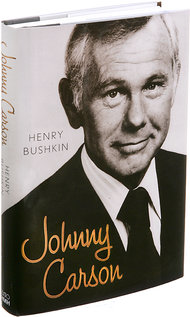 Johnny Carson by Henry Bushkin Imagine that you have a good friend with whom you visit on a regular basis for more than 15 years . He died several years ago and you learn that someone who knew him very well has just written a book about him. You probably would be very drawn to want to read that book as was I when this book came out about Johnny Carson. I would periodically watch the Tonite Show, which he hosted for thirty years between 1962 and 1992. The book was written by Henry Bushkin, who Carson once described as his best friend. Bushkin met Carson in 1970 when he was interviewed by him and hired as his personal attorney when Bushkin was just a few years out of law school. As I got into the book I developed the uncomfortable feeling that not only was the author not being a very loyal friend by revealing Carson’s personal life and depicting him as mostly not a very nice guy, but that he also was breaching his code of ethics as a lawyer by discussing things that were told to him in his role as Carson’s attorney. (I understand that lawyers may debate the issue of whether such lawyer client privilege exists after death.) For example very early in his tenure as Carson’s lawyer he accompanied him and a small raiding party that broke into Carson’s second wife’s apartment in which she was living while they were separated. She wasn’t there at the time and the purpose of the break-in was to discover evidence that she was having an affair which they did find. Bushkin was ready to answer the police if they were caught by claiming that it was Johnny’s apartment since he was providing all his wife’s financial support at that time. There was a time during Carson’s run with NBC when his contract was due to run out and he was being courted by ABC. All the behind the scenes secret details how Bushkin and Carson led ABC on to think that they might go with them while using the inducements being offered to them by ABC to extract more from NBC were revealed. Johnny’s marital infidelities were also freely discussed with a hint that Bushkin was also cheating on his own wife. In fact, Bushkin’s explanation for his own wife leaving him was because she couldn’t tolerate his putting Carson over her as he would be frequently away in the evening as well as out of town whenever Carson traveled and needed him. Perhaps the most remarkable aspect of this book was the depiction of Johnny Carson’s character as a superficial man who had very little capacity to care about other people. He was shown to have no meaningful relationship with his sons when they were children or adults. When Joan Rivers, who he invited to be a substitute host for him on his show many times, accepted a deal to have her own show on another network opposite his show, he never spoke with her again. His need to be praised and adored by others, as well as his questionable honesty, was illustrated by how he played tennis. Bushkin who apparently was an excellent tennis player was expected to play tennis with Carson, who loved the game, Bushkin noted that Carson would frequently call line shots in his favor even when they were not and would accept (and apparently expect) Bushkin calling them in Carson’s favor even when they were not. Bushkin attributed Carson’s inability to have genuine caring relationships to be related to his mother Ruth who was described as a nasty person. It was clear that Bushkin became a very wealthy man himself as result of his association with Carson and participation in some of the business deals that he helped set up for his boss. Carson eventually fired Bushkin in 1988 because he felt that he was not being totally loyal to him and did not put Carson’s interest above his own. Therefore it should be of little surprise as with this book Carson’s “good friend” and attorney appears to care little about preserving his legacy and reputation as the warm likeable guy that so many people spent so many evenings with as they enjoyed The Tonite Show. The end product which he produced is really quite superficial and probably doesn’t “tell all” but certainly “belittles much” about Johnny . Don’t reward the author as I did by purchasing this book. If you must read it, take it out from the library.
Johnny Carson by Henry Bushkin Imagine that you have a good friend with whom you visit on a regular basis for more than 15 years . He died several years ago and you learn that someone who knew him very well has just written a book about him. You probably would be very drawn to want to read that book as was I when this book came out about Johnny Carson. I would periodically watch the Tonite Show, which he hosted for thirty years between 1962 and 1992. The book was written by Henry Bushkin, who Carson once described as his best friend. Bushkin met Carson in 1970 when he was interviewed by him and hired as his personal attorney when Bushkin was just a few years out of law school. As I got into the book I developed the uncomfortable feeling that not only was the author not being a very loyal friend by revealing Carson’s personal life and depicting him as mostly not a very nice guy, but that he also was breaching his code of ethics as a lawyer by discussing things that were told to him in his role as Carson’s attorney. (I understand that lawyers may debate the issue of whether such lawyer client privilege exists after death.) For example very early in his tenure as Carson’s lawyer he accompanied him and a small raiding party that broke into Carson’s second wife’s apartment in which she was living while they were separated. She wasn’t there at the time and the purpose of the break-in was to discover evidence that she was having an affair which they did find. Bushkin was ready to answer the police if they were caught by claiming that it was Johnny’s apartment since he was providing all his wife’s financial support at that time. There was a time during Carson’s run with NBC when his contract was due to run out and he was being courted by ABC. All the behind the scenes secret details how Bushkin and Carson led ABC on to think that they might go with them while using the inducements being offered to them by ABC to extract more from NBC were revealed. Johnny’s marital infidelities were also freely discussed with a hint that Bushkin was also cheating on his own wife. In fact, Bushkin’s explanation for his own wife leaving him was because she couldn’t tolerate his putting Carson over her as he would be frequently away in the evening as well as out of town whenever Carson traveled and needed him. Perhaps the most remarkable aspect of this book was the depiction of Johnny Carson’s character as a superficial man who had very little capacity to care about other people. He was shown to have no meaningful relationship with his sons when they were children or adults. When Joan Rivers, who he invited to be a substitute host for him on his show many times, accepted a deal to have her own show on another network opposite his show, he never spoke with her again. His need to be praised and adored by others, as well as his questionable honesty, was illustrated by how he played tennis. Bushkin who apparently was an excellent tennis player was expected to play tennis with Carson, who loved the game, Bushkin noted that Carson would frequently call line shots in his favor even when they were not and would accept (and apparently expect) Bushkin calling them in Carson’s favor even when they were not. Bushkin attributed Carson’s inability to have genuine caring relationships to be related to his mother Ruth who was described as a nasty person. It was clear that Bushkin became a very wealthy man himself as result of his association with Carson and participation in some of the business deals that he helped set up for his boss. Carson eventually fired Bushkin in 1988 because he felt that he was not being totally loyal to him and did not put Carson’s interest above his own. Therefore it should be of little surprise as with this book Carson’s “good friend” and attorney appears to care little about preserving his legacy and reputation as the warm likeable guy that so many people spent so many evenings with as they enjoyed The Tonite Show. The end product which he produced is really quite superficial and probably doesn’t “tell all” but certainly “belittles much” about Johnny . Don’t reward the author as I did by purchasing this book. If you must read it, take it out from the library.
Comment » | B - Biography
November 19th, 2013 — 1:03am
 Americanah by Chimamanda Ngozi Adichie This is a novel about Ifemelu an attractive bright young woman who grows up in Lagos, a city in Nigeria. She falls in love with Obinze and they seem to be a perfect pair meant for each other. However like many educated young people from Nigeria she is driven to explore horizons beyond her environment and finds a way to come to America. We are able to follow her on this at times torturous journey. We come to understand her relationships with the people that she meets and her love life with several men as well as her career which includes, not surprisingly, being a writer and eventually a blogger. We see through her eyes how she is viewed by Americans both black and white and the distinctions that she draws between Non-African Black and African Black. The reader gains thoughtful and at times jolting insights into the complexities of the meaning of what might be considered an incidental task and that is how she decides to have her hair done. Ifemelu’s decision to return to Nigeria allows the reader to gain a further prospective on some of the views of her countrymen and women towards America as well as her view of her country based on her years of living in the U.S. Make no mistake, Ifemelu the main character should not be considered a stereotype of Africans or even of Nigerians. She is a product of her environment and all the experiences to which she has been exposed. Her life and the choices which she makes can be understood and identified with by many of the readers from different backgrounds. The idea that there is no single story for one group of people is something very important to the author.
Americanah by Chimamanda Ngozi Adichie This is a novel about Ifemelu an attractive bright young woman who grows up in Lagos, a city in Nigeria. She falls in love with Obinze and they seem to be a perfect pair meant for each other. However like many educated young people from Nigeria she is driven to explore horizons beyond her environment and finds a way to come to America. We are able to follow her on this at times torturous journey. We come to understand her relationships with the people that she meets and her love life with several men as well as her career which includes, not surprisingly, being a writer and eventually a blogger. We see through her eyes how she is viewed by Americans both black and white and the distinctions that she draws between Non-African Black and African Black. The reader gains thoughtful and at times jolting insights into the complexities of the meaning of what might be considered an incidental task and that is how she decides to have her hair done. Ifemelu’s decision to return to Nigeria allows the reader to gain a further prospective on some of the views of her countrymen and women towards America as well as her view of her country based on her years of living in the U.S. Make no mistake, Ifemelu the main character should not be considered a stereotype of Africans or even of Nigerians. She is a product of her environment and all the experiences to which she has been exposed. Her life and the choices which she makes can be understood and identified with by many of the readers from different backgrounds. The idea that there is no single story for one group of people is something very important to the author.
After I completed this book, I wanted to know to know more about the author.I found this video clip of Ngozi Adichie giving the prestigious TED lecture. I highly recommend it to anyone who may be considering spending time with this novel as it will give you an idea of intelligence and thoughtfulness of the author
The link is :
http://www.ted.com/talks/chimamanda_adichie_the_danger_of_a_single_story.html?quote=559
There was a passage in the book which was one of several blogs written by Ifemelu, which struck me as a clear descriptions of racism in America. While it is only a small part of the book, I thought it was worth repeating and using it to demonstrate the value of reading this book:
Understanding America for the Non-American Black: A few Explanations of What Things Really Mean
1-Of all their tribalisms, Americans are most uncomfortable with race, If you are having a conversation with an American, and you want to discuss something racial that you find interesting, and the American says, “ Oh, it’s simplistic to say it’s race, racism is so complex,” it means they just want you to shut up already, Because of course racism is complex. Many abolitionists wanted to free the slaves but didn’t want black people living nearby. Lots of folk today don’t mind a black nanny or black limo driver. But they sure as hell mind a black boss. What is simplistic is saying “It’s so complex.” But shut up anyway, especially if you need a job/favor from the American in question.
2. Diversity means different things to different folks. If a white person is saying a neighborhood is diverse, they mean nine percent black people (the minute it gets to ten percent black people, the white folk move out.) If a black person says diverse neighborhood, they are thinking forty percent black.
3. Sometimes they say “culture” when they mean race. They say a film is “mainstream” when they mean “white folks like it or made it,” When they say “urban” it means black and poor and possibly dangerous and potentially exciting. “Racially charged” means we are uncomfortable saying “racist.”
Comment » | FG - Fiction General, FR - Fiction Romance
November 1st, 2013 — 10:39am
Still Foolin’ ‘Em by Billy Crystal –  March 14, 2013, Billy Crystal was 65 years old. He now lives in Los Angeles and has been married to the same woman and has two daughters and 4 grandchildren. He is a very popular comedian as well as an actor and director. He is best known for the movies When Harry Met Sally, City Slickers and Analyze This. He has hosted the Oscars on TV nine times, has won several Emmys and has starred on Broadway and around the country with his Tony award winning one man shows 700 Sundays in which he relives his childhood where his father died when he was 15 years old.
March 14, 2013, Billy Crystal was 65 years old. He now lives in Los Angeles and has been married to the same woman and has two daughters and 4 grandchildren. He is a very popular comedian as well as an actor and director. He is best known for the movies When Harry Met Sally, City Slickers and Analyze This. He has hosted the Oscars on TV nine times, has won several Emmys and has starred on Broadway and around the country with his Tony award winning one man shows 700 Sundays in which he relives his childhood where his father died when he was 15 years old.
This book is his reflections on his life as he reaches this milestone of 65 years. It is personal, funny, revealing and an inside view of show business life in New York and Los Angeles. He shares personal stories about his family and friends. The latter include Mohammad Ali, Rob Reiner, Mickey Mantle, Dick Schaap, Bob Costas, Richards Lewis to name just a few and hundreds of other very well know persons with whom be came very close as they worked together including Sophia Loren who he mainly knew in his fantasy life.
This book is far from superficial. He goes into great detail on subjects from the making of When Harry Met Sally, his meticulous preparation for the Oscar TV shows and the rituals before each performance of 700 Sundays. He also is quite elaborate about the dying and death of his beloved Uncle Bern. He even devotes an entire chapter to going to buy a cemetery plot for himself and his wife. Crystal shares an event which is the contender for the highlight of his life (along with the birth of his children and grandchildren and some other events) and that is the day he was made a member of the New York Yankees so he could get one time at bat in a game against a major league pitcher. (He fouled off one pitch with a line drive down the right field line and than ran the count to 3 and 2…) Baseball was a very important part of his life.
There is no false modesty in this book. Crystal shares the details of a very successful career. If you have enjoyed seeing him perform over the years you will love this book.
Comment » | AM - Autobiography or Memoir
November 1st, 2013 — 12:29am
 The Circle by Dave Eggers Some of you may have read George Orwell’s 1949 book titled 1984 in which he envisioned a time in the future when “ Big Brother” will always be watching you. That book predicted a society in which everyone was under scrutiny by the omnipresent government. Now almost 65 years after the publication of that book Dave Eggers comes out with The Circle in which he envisions a society where everyone is under scrutiny by everyone else.
The Circle by Dave Eggers Some of you may have read George Orwell’s 1949 book titled 1984 in which he envisioned a time in the future when “ Big Brother” will always be watching you. That book predicted a society in which everyone was under scrutiny by the omnipresent government. Now almost 65 years after the publication of that book Dave Eggers comes out with The Circle in which he envisions a society where everyone is under scrutiny by everyone else.
The story opens as Mae, a young woman a few years out of college is about to take a job with the most avant-garde company (think a combination of Apple, Google, Microsoft). As expected she encounters a beautiful campus with every amenity to make the life of it’s employees comfortable and worry free. She soon learns that to do the job that is expected, one must be responsive to your customers and co-workers. There may seem to be nothing unusual about this well-known business principle. But the day of easy communication via computer, phone and now a special wristband is easy to do but involves very large numbers of interested coworkers and the now involved general public which in turn requires massive meticulous tracking procedures. So at a worker’s desk at this wonderful company there are at least 2 large computer screen keeping track of 1000s of customer responses and a growing numbers of “friends” and co-workers with whom you meet and interact The number of screens at your desk will soon grow as will the time a conscientious worker spends responding to messages. There is of course some built in competition for those who want to be recognized for doing a good job. But no worry, workers can stay overnight in special beautiful hotel like dormitories and there are all sorts of educational and social programs on campus.
There are special programs built in to keep track where everybody is at any moment (our new cell phones do that today). This is just the tip of the iceberg. The story of The Circle is not just about the ever increasing amount of information and data that can be accumulated, tracked and used for seemingly good purposes. The book is also about a handful of people in addition to Mae and Annie (her friend who brought her to the company and has been one of her biggest advocates) and how this new information culture is impacting on them and the people around them. For example, Mae’s parents initially are so happy to benefit by being given free quality health insurance because Mae is their daughter. They soon will regret they and their daughter ever had anything to do with this massive corporation. The company comes up with an invention in which a person wears a camera around his or her neck and just about everything they do and experience is traceable on this world wide communication system. A politician volunteers to wear this camera and becomes “ transparent” so no one can ever accuse her of being two faced, secretive or untruthful because everything she does is known. Soon most politicians end up doing the same thing.
Most intriguing are the three founders or “ leaders” of the company (remind you of the term used for the honchos in China?). There is Ty, the young techno genius who may not have thought through all the implications of his initial innovations, which led to the founding of the company. There is Bailey, another one of the big three leaders, who believes that knowing and seeing all will lead to a better world for all. Then there is Stetson , the cold calculating man who realizes that the more you control, the more money the company can make. By encompassing these 3 characteristics as three different people who together embody the company, we are better able to understand the essence of The Circle (name of the company) which is about to come around 360 degrees and essentially take over the lives of everyone.
Do not fret, you can safely read this book on your electronic reader. You will have control on your Facebook who you want to friend and you can decide if you want to Tweet. It also isn’t necessary for you to carry an open camera for everyone on earth to have access to you. But what if everyone else did this and suggested that you had something to hide? Perhaps the circle is closing faster than we realize.
Comment » | FG - Fiction General, FSF - Fiction Science Fiction
October 10th, 2013 — 11:59pm
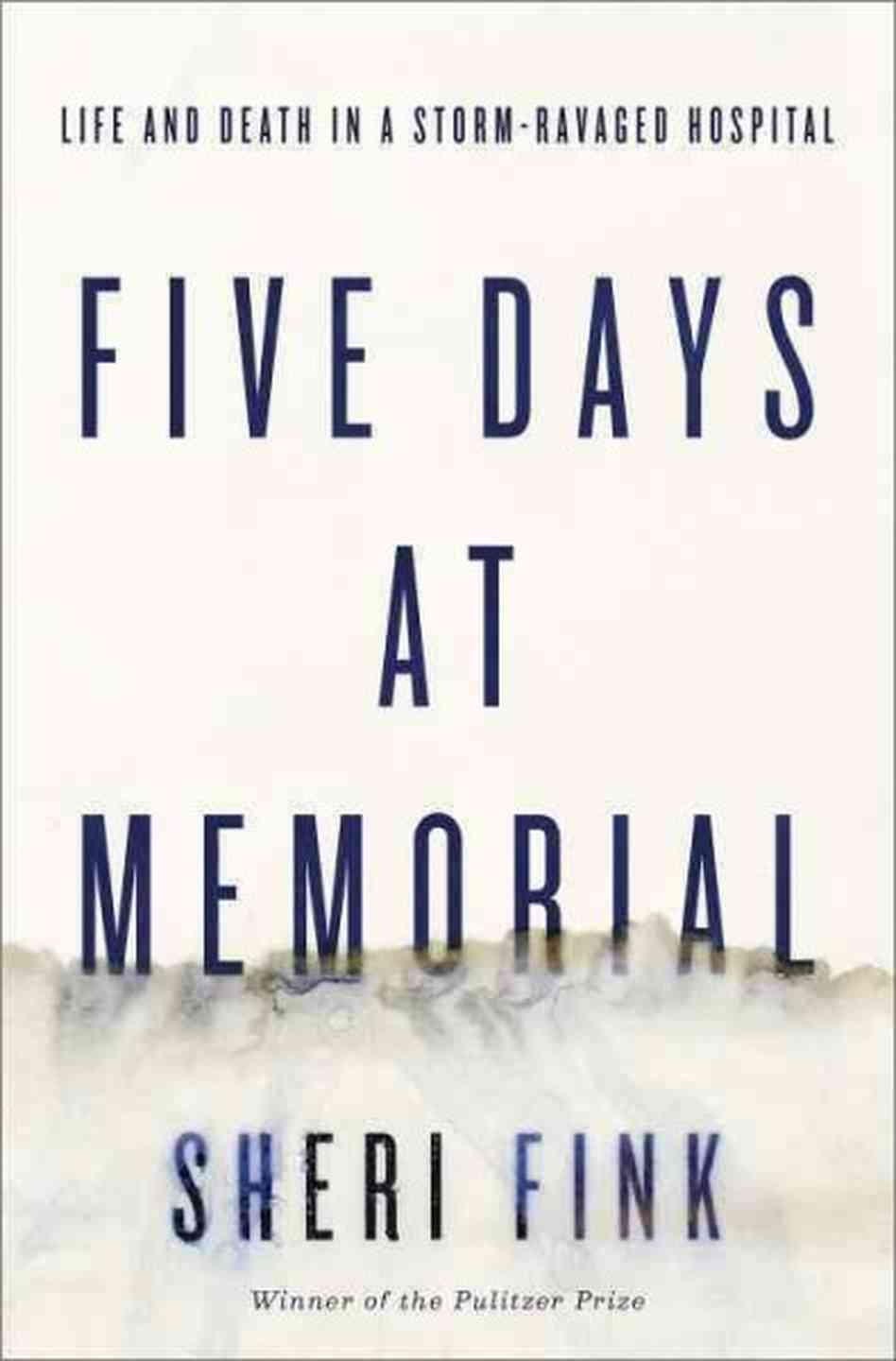 5 Days at Memorial: Life and Death in a Storm Ravaged Hospital by Sheri Fink – This is a great book for anyone who works in a hospital especially doctors and nurses who realize they could be on call when a disaster might strike. Also include yourself in this group if you are a hospital administrator or someone who likes to wrestle with ethical dilemmas. Be prepared for a lot of repetition, medical details that may all seem to be almost the same to most people as well as for some dips into the history of this hospital, other disasters and a course in ethics over the years even dating back to ancient times. If you can handle all of this, you really have an exciting, intellectually stimulating book with a look at disaster medicine, making medical and ethical decisions under difficult circumstances and some good legal battles. The main event was the 2005 Hurricane Katrina, which was the costliest natural disaster, as well as one of the five deadliest hurricanes in the history of the United States. At least 1,833 people died in the hurricane and subsequent floods. This book deals with the impact of the storm on Memorial Hospital in New Orleans, which was a 312-bed hospital, which included patients receiving intensive care and a larger section of the hospital where critically ill patients were treated. As the floodwater rose, most of the power in the hospital was irretrievably lost. There was no sanitation, and they were running out of food. Indoor temperatures were as high as 110 F degrees. At one point there were over 2000 people in the hospital as the numbers swelled with families of patients and staff as well as refugees from the surrounding city. The hospital became surrounded by water and there was no way to leave by car. A makeshift helipad was established on the roof but to get there patients, had to be carried up several flights of stairs usually in the dark and passed through a hole in the wall to get to another part of the hospital complex and up additional stairs. There was limited oxygen for these patients and for some the nurses had to squeeze a balloon like device to get the air into their lungs and drip an IV into their veins while going up the stairs. It was difficult getting enough helicopters to remove all the people from the hospital. Decisions had to be made which patients to evacuate first. Should it be the ones that were barely alive and wouldn’t be expected to even survive the trip to another location or perhaps already had a fatal illness where their demise was expected in a few days or should the patients go first who had a better long term outlook but still required hospital care?? Should the preference or order of care be influenced if the patient had a DNR order, meaning do not resuscitate the patient if their heart stops or if they stop breathing. As the first three or four days passed most of the people were evacuated (where they were evacuated to was another problem). There was confusion and questions about the actions by the corporation that owned the hospital and what arrangements they were making to help the stranded hospital’s need for evacuation. Outside the hospital gunshots were heard and there were concerns that looters might enter the hospital by boat. There was a concern about the physical integrity of the old hospital walls. You would think that the National Guard and the US Government should have done a heroic operation to save everyone from the beginning. They apparently were saving people from rooftops of their homes, helping out in the Superdome, which was the place of last resort for the people of New Orleans who weren’t able to escape before the flood, as well as sporadically appearing on the helicopter pad. In the end there were a small number of doctors and nurses trying to care for the remaining and sickest patients. There was concern that even moving some of them would be fatal. One man was so obese that they couldn’t figure out how to move him. Some patients were clearly in the last hours hours of their lives. Others would soon be that way if they didn’t get more intensive care. One of the remaining doctors along with two nurses was Dr. Anna Pous, a very compassionate and brilliant ENT surgeon who had a history of reconstructing patients with advanced cancer. She found herself faced with the task of trying to relieve the suffering of several remaining patients. It is well known to physicians and nurses who treat dying patients, that morphine often in combination with a rapid acting tranquillizer such as Versed, given intravenous will relieve the pain and agonizing difficulty breathing in the final stages of life. It is also known that this treatment could hasten their demise. Dr. Pous appeared to have made the decision to have several patients receive large doses of morphine and Versed, which would painlessly end their lives. At a later point in time , this action was felt by some people to be murder. In fact, Dr. Pous was actually arrested, handcuffed and was with two nurses charged with second-degree murder. The response of the medical community from this hospital and from across the country, the legal and emotional reactions of some of the patient’s families, the media hype and the ethical questions which were being asked, were an important part of this book. The book provides few answers and lots of stimulating questions. The author won a Pulitzer Prize for her reporting on this subject in the New York Times Magazine. If you are drawn to this subject you will not be disappointed.
5 Days at Memorial: Life and Death in a Storm Ravaged Hospital by Sheri Fink – This is a great book for anyone who works in a hospital especially doctors and nurses who realize they could be on call when a disaster might strike. Also include yourself in this group if you are a hospital administrator or someone who likes to wrestle with ethical dilemmas. Be prepared for a lot of repetition, medical details that may all seem to be almost the same to most people as well as for some dips into the history of this hospital, other disasters and a course in ethics over the years even dating back to ancient times. If you can handle all of this, you really have an exciting, intellectually stimulating book with a look at disaster medicine, making medical and ethical decisions under difficult circumstances and some good legal battles. The main event was the 2005 Hurricane Katrina, which was the costliest natural disaster, as well as one of the five deadliest hurricanes in the history of the United States. At least 1,833 people died in the hurricane and subsequent floods. This book deals with the impact of the storm on Memorial Hospital in New Orleans, which was a 312-bed hospital, which included patients receiving intensive care and a larger section of the hospital where critically ill patients were treated. As the floodwater rose, most of the power in the hospital was irretrievably lost. There was no sanitation, and they were running out of food. Indoor temperatures were as high as 110 F degrees. At one point there were over 2000 people in the hospital as the numbers swelled with families of patients and staff as well as refugees from the surrounding city. The hospital became surrounded by water and there was no way to leave by car. A makeshift helipad was established on the roof but to get there patients, had to be carried up several flights of stairs usually in the dark and passed through a hole in the wall to get to another part of the hospital complex and up additional stairs. There was limited oxygen for these patients and for some the nurses had to squeeze a balloon like device to get the air into their lungs and drip an IV into their veins while going up the stairs. It was difficult getting enough helicopters to remove all the people from the hospital. Decisions had to be made which patients to evacuate first. Should it be the ones that were barely alive and wouldn’t be expected to even survive the trip to another location or perhaps already had a fatal illness where their demise was expected in a few days or should the patients go first who had a better long term outlook but still required hospital care?? Should the preference or order of care be influenced if the patient had a DNR order, meaning do not resuscitate the patient if their heart stops or if they stop breathing. As the first three or four days passed most of the people were evacuated (where they were evacuated to was another problem). There was confusion and questions about the actions by the corporation that owned the hospital and what arrangements they were making to help the stranded hospital’s need for evacuation. Outside the hospital gunshots were heard and there were concerns that looters might enter the hospital by boat. There was a concern about the physical integrity of the old hospital walls. You would think that the National Guard and the US Government should have done a heroic operation to save everyone from the beginning. They apparently were saving people from rooftops of their homes, helping out in the Superdome, which was the place of last resort for the people of New Orleans who weren’t able to escape before the flood, as well as sporadically appearing on the helicopter pad. In the end there were a small number of doctors and nurses trying to care for the remaining and sickest patients. There was concern that even moving some of them would be fatal. One man was so obese that they couldn’t figure out how to move him. Some patients were clearly in the last hours hours of their lives. Others would soon be that way if they didn’t get more intensive care. One of the remaining doctors along with two nurses was Dr. Anna Pous, a very compassionate and brilliant ENT surgeon who had a history of reconstructing patients with advanced cancer. She found herself faced with the task of trying to relieve the suffering of several remaining patients. It is well known to physicians and nurses who treat dying patients, that morphine often in combination with a rapid acting tranquillizer such as Versed, given intravenous will relieve the pain and agonizing difficulty breathing in the final stages of life. It is also known that this treatment could hasten their demise. Dr. Pous appeared to have made the decision to have several patients receive large doses of morphine and Versed, which would painlessly end their lives. At a later point in time , this action was felt by some people to be murder. In fact, Dr. Pous was actually arrested, handcuffed and was with two nurses charged with second-degree murder. The response of the medical community from this hospital and from across the country, the legal and emotional reactions of some of the patient’s families, the media hype and the ethical questions which were being asked, were an important part of this book. The book provides few answers and lots of stimulating questions. The author won a Pulitzer Prize for her reporting on this subject in the New York Times Magazine. If you are drawn to this subject you will not be disappointed.
Comment » | HI - History, M - Medical
September 27th, 2013 — 10:51am
 The Light Between Oceans by H. L. Stedman – Tom Sherbourne is a young World War I veteran who takes an honorable job as a lighthouse keeper 100 miles off the coast of Australia. On leave in the mainland he meets and falls in love and marries Isabel who is very happy to join him in the lighthouse keepers home on an isolated island. Still early in the book, we learn of the all important incident where a small boat washes ashore with a dead man in it and a new born baby. By now Isabel has had three miscarriages and Tom and Isabel conclude the mother of the baby must have been lost at sea. They bury the man and keep and raise the baby as their own especially since it coincides with her latest expected but failed childbirth. As the story unfolds we learn much more about Tom and Isabel and about other people whose lives are related to this incident. We become drawn in to the complexities and deepest feeling of many of them. The author allows us to understand where the characters come from and where they are going . She puts us inside their heads as they struggle with their psychological pain and their decision-making processes. It is remarkable that included in this study of people is an insight into the baby girl who we meet shortly after her birth and watch her develop for the first five years of her life. The reader is drawn to the many interrelated characters in the book. To understand them is to empathize and like them. The book also gives the reader an insight into the impact of World War I on not only the participants and the returning young veterans but on the so many parents who never recover from what the war did to their families. But most of all this is a story about one big ethical dilemma that has the power to rip you apart if you put yourself in the shoes of all involved. This is a well-written novel which grabs you and makes you not want to put it down. When I finally did put it down after completing it I realize that it stirs up thoughts about a topic, which I have been thinking and writing about in recent months. That is the powerful desire of people to find their hidden roots and make personal contact with close relatives from whom they have been separated at an early stage in their lives or those related to them. ( See my blog on this subject ) . Whenever you encounter a book that holds your attention as this one did and stimulates interesting thoughts, it certainly is a book that deserves recommending to others
The Light Between Oceans by H. L. Stedman – Tom Sherbourne is a young World War I veteran who takes an honorable job as a lighthouse keeper 100 miles off the coast of Australia. On leave in the mainland he meets and falls in love and marries Isabel who is very happy to join him in the lighthouse keepers home on an isolated island. Still early in the book, we learn of the all important incident where a small boat washes ashore with a dead man in it and a new born baby. By now Isabel has had three miscarriages and Tom and Isabel conclude the mother of the baby must have been lost at sea. They bury the man and keep and raise the baby as their own especially since it coincides with her latest expected but failed childbirth. As the story unfolds we learn much more about Tom and Isabel and about other people whose lives are related to this incident. We become drawn in to the complexities and deepest feeling of many of them. The author allows us to understand where the characters come from and where they are going . She puts us inside their heads as they struggle with their psychological pain and their decision-making processes. It is remarkable that included in this study of people is an insight into the baby girl who we meet shortly after her birth and watch her develop for the first five years of her life. The reader is drawn to the many interrelated characters in the book. To understand them is to empathize and like them. The book also gives the reader an insight into the impact of World War I on not only the participants and the returning young veterans but on the so many parents who never recover from what the war did to their families. But most of all this is a story about one big ethical dilemma that has the power to rip you apart if you put yourself in the shoes of all involved. This is a well-written novel which grabs you and makes you not want to put it down. When I finally did put it down after completing it I realize that it stirs up thoughts about a topic, which I have been thinking and writing about in recent months. That is the powerful desire of people to find their hidden roots and make personal contact with close relatives from whom they have been separated at an early stage in their lives or those related to them. ( See my blog on this subject ) . Whenever you encounter a book that holds your attention as this one did and stimulates interesting thoughts, it certainly is a book that deserves recommending to others
Comment » | FG - Fiction General
September 24th, 2013 — 6:52pm
 Over the Waterfall by Marilyn Martone- This book was given to me by my cousin who is a rehabilitation counselor and social worker case manager and is mentioned in the book as being some assistance to the author and her daughter. The book is brought about because of a tragic accident in which Michelle, the 21-year-old daughter of the author, was hit by a car and suffered a terrible traumatic brain injury. In one split second a vibrant, brilliant college student was put into a coma, which lasted for months, which would be followed by a very slow and gradual improvement which meant that her life and the life of her family would never be the same. The author and mother brought a unique perspective to this life-changing event , in that she has a master’s degree in health-care ethics and a PhD in moral theology. She had taught classes concerning how to deal with people and their families who had loved ones in coma and had been faced with making critical decisions. Despite this background she was not prepared for how this would impact upon her. She never imagined the role she would play by being at her daughter’s bedside frequently for the most of the day and night for months at a time and of the admissions to several different hospitals. She had to deal with a range of problems and decisions which included having to sign consents without knowing if it were really the best thing for her daughter, seeing doctors , nurses and hospitals make mistakes which she was able to catch, knowing the best nursing techniques that the staff would frequently not know, figuring out how to navigate the desire of the hospital to discharge her daughter to lower level of care for economic reasons etc. Most important to her was her mission to make sure the hospital staff viewed her daughter as the person she was rather than the case with the specific injuries. I am no stranger to medical and surgical settings in a hospital, which ranged from critical care to rehabilitation. For many years I was a psychiatric consultant to a large hospital , which was also a trauma and burn center. While I have seen many of the issues that are discussed in this book in a variety of different patients, I have never had the opportunity to appreciate how it could impact one person over a considerable period of time. This soft covered, self published book is 203 pages and it flows easily. In the end we don’t know the extent of the residual damage to her daughter but do know that she is on a path of constantly improving. We do know something about the human spirit, faith and the dedication of the mother and family of Michelle. Having shared part of this major journey with the author, we also have much more insight into what is involved for the family and how their lives were changed. If we are healthcare workers , we certainly are the richer for the insight provided to us. We all will come away from this book with greater empathy for anyone who must go through this ordeal.
Over the Waterfall by Marilyn Martone- This book was given to me by my cousin who is a rehabilitation counselor and social worker case manager and is mentioned in the book as being some assistance to the author and her daughter. The book is brought about because of a tragic accident in which Michelle, the 21-year-old daughter of the author, was hit by a car and suffered a terrible traumatic brain injury. In one split second a vibrant, brilliant college student was put into a coma, which lasted for months, which would be followed by a very slow and gradual improvement which meant that her life and the life of her family would never be the same. The author and mother brought a unique perspective to this life-changing event , in that she has a master’s degree in health-care ethics and a PhD in moral theology. She had taught classes concerning how to deal with people and their families who had loved ones in coma and had been faced with making critical decisions. Despite this background she was not prepared for how this would impact upon her. She never imagined the role she would play by being at her daughter’s bedside frequently for the most of the day and night for months at a time and of the admissions to several different hospitals. She had to deal with a range of problems and decisions which included having to sign consents without knowing if it were really the best thing for her daughter, seeing doctors , nurses and hospitals make mistakes which she was able to catch, knowing the best nursing techniques that the staff would frequently not know, figuring out how to navigate the desire of the hospital to discharge her daughter to lower level of care for economic reasons etc. Most important to her was her mission to make sure the hospital staff viewed her daughter as the person she was rather than the case with the specific injuries. I am no stranger to medical and surgical settings in a hospital, which ranged from critical care to rehabilitation. For many years I was a psychiatric consultant to a large hospital , which was also a trauma and burn center. While I have seen many of the issues that are discussed in this book in a variety of different patients, I have never had the opportunity to appreciate how it could impact one person over a considerable period of time. This soft covered, self published book is 203 pages and it flows easily. In the end we don’t know the extent of the residual damage to her daughter but do know that she is on a path of constantly improving. We do know something about the human spirit, faith and the dedication of the mother and family of Michelle. Having shared part of this major journey with the author, we also have much more insight into what is involved for the family and how their lives were changed. If we are healthcare workers , we certainly are the richer for the insight provided to us. We all will come away from this book with greater empathy for anyone who must go through this ordeal.
Comment » | AM - Autobiography or Memoir, M - Medical
September 21st, 2013 — 5:58pm
Old Filth by James Gardau – 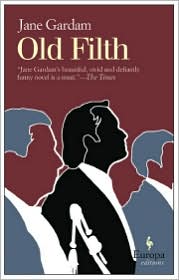 This novel is the story of the life and death of Sir Edward Feathers, subject of the British Empire. He happened to be a barrister who went on to be a judge. The origin of his name is Failed In London Try Hong Kong. Although this moniker stuck with him and may have been hurtful although that was never mentioned. He was far from a failure. In fact he is an example of what the human spirit can accomplish no matter what kind of early childhood cards are dealt to you. But it is also a tale of the scars of early childhood.
This novel is the story of the life and death of Sir Edward Feathers, subject of the British Empire. He happened to be a barrister who went on to be a judge. The origin of his name is Failed In London Try Hong Kong. Although this moniker stuck with him and may have been hurtful although that was never mentioned. He was far from a failure. In fact he is an example of what the human spirit can accomplish no matter what kind of early childhood cards are dealt to you. But it is also a tale of the scars of early childhood.
Old Filth started off life by losing his mother 3 days after he was born outside of England. His father arranged for the wet nurse and her young daughter to take him in in their house. It was the teen age Malaysian girl who took care of him for his first five years and it seemed that he had no other parental figure. He was then sent to England to be raised by a foster family whom he felt never loved or cared for him. He did have a relationship with two young cousins who also were involved in this extended foster family. Those children who came from the far-flung Empire were known as Raj Orphans. His father a World War I veteran and an alcoholic, paid for his schools although he didn’t visit him. As an older teen he felt at home with a school buddy’s family on holidays. When World War II broke out, although he was almost of college age, his father arranged for him to be sent to Singapore because of concern about the German bombings in the same manner as younger children were being evacuated from Europe. That turned out to be an ill fated boat trip and although he had passed his entrance exams for Oxford, he enlisted in the army. He was assigned to a remote part of England to guard Queen Mary and amazingly developed a somewhat friendly relationship with her. Post war he pursued his education and then a successful legal career in Hong Kong where he even becomes a prominent judge
He was married to Betty for many years, but did not have any children. We ultimately learn that the marriage may not have been what he thought it was, as it turns out that she had an affair with a man who became a neighbor later in his life. What shines through this tale is that despite his great success and even a seemingly happy marriage (despite the few indiscretions by his wife), was a deep feeling of emptiness and frequently feelings of rejection. Much of the book focuses on his loneliness after his wife dies in their old age. The sadness of his reflections suggests that he always felt something was missing in his life. Could it be that he didn’t have the love of parental figures when he really needed it?
While I found the numerous transitions back and forth to different stages in his life quite disruptive and distracting, it did allow for the reader to examine and understand his youth and middle years while being with him and seeing his life from his vantage point as an older man. I do admit for me at times these were tedious journeys.
This book is dealing with memories and the significance of past experiences. In this regard, the author reminds us how a single incident can stay with one for a lifetime even if that memory is a distorted one. This situation was described in just a few pages of one important event in Filth’s life. This dates back to his preteen years where he and his cousins were with the foster mother whom they despised because of the way she treated them. They even spoke among themselves how they would like to kill her. Then in an incident at the top of a large staircase, the young Filth, struggling with her about something or other, pushes the foster mother and she falls down the stars leading to her death. In his old age, he wishes to confess this deed to a Priest in the presence of one his cousins, who had been there with him at the time of the incident. He relates how the foster mother was found dead at the foot of the stairs after he pushed her. The cousin mentions that actually the woman died the next day at the hospital and was found to have end stage cancer of which she would have died shortly anyway. Filth is stunned and says, “I never knew that!” How would his feeling have been different about himself and his life had he known he did not cause her death? How would all his trials and tribulations been different if he had been loved and listened to throughout his years?
Comment » | FG - Fiction General
 Serena by Ron Rash– In a recent book review of the best seller Gone Girl , I noted that despite that book being a very exciting mystery, there was a paucity of information about the background and psychological make up of the two protagonists. Similarly, Serena offers us two very strong characters, Serena and her husband Pemberton, with an interesting but certainly not a page turning, edge of your seat mystery. There is no significant in-depth backstory that really allows us to understand the characters and why they are who they are and how they got there. This certainly does not have to be the mission of every novel but without it we have to evaluate what have we been given? In this case it is an insight into the lives of the mostly men and some women who cut, sawed and hacked their way across the Appalachian mountains of North Carolina, Tennessee and surrounding areas in the late 1920s and early 30s’ while the country was in a depression. We came to appreciate the hardship and, at times, danger to life and limb that these lumbermen experienced. We get a glimpse at the movement to develop a national park system and the conflict with the entrepreneurs who were buying up the land to take the trees and minerals while essentially leaving it bare. We also meet a unique married couple who are not only the bosses of a company that is engaged in these practices but who also embody a mean spirited perhaps “evil” nature. They will think nothing of endangering their workers, manipulating and lying to potential business partners and doing whatever has to be done to achieve their ends. This includes a willingness to murder anyone. Thus the book in one sense is a morality play with the workers talking among themselves acting like a Greek chorus highlighting the code of ethics or rather lack of them which are being acted out. Serena, herself emerges as a person who burnt her bridges behind her (although we don’t quite really understand what they were made of) and would do anything to be the timber baroness of the US and then of Brazil. Her singlemindedness becomes frightening and is made of the stuff that would make her an ideal role for any great actress to undertake when Serena , the movie,is ultimately made.
Serena by Ron Rash– In a recent book review of the best seller Gone Girl , I noted that despite that book being a very exciting mystery, there was a paucity of information about the background and psychological make up of the two protagonists. Similarly, Serena offers us two very strong characters, Serena and her husband Pemberton, with an interesting but certainly not a page turning, edge of your seat mystery. There is no significant in-depth backstory that really allows us to understand the characters and why they are who they are and how they got there. This certainly does not have to be the mission of every novel but without it we have to evaluate what have we been given? In this case it is an insight into the lives of the mostly men and some women who cut, sawed and hacked their way across the Appalachian mountains of North Carolina, Tennessee and surrounding areas in the late 1920s and early 30s’ while the country was in a depression. We came to appreciate the hardship and, at times, danger to life and limb that these lumbermen experienced. We get a glimpse at the movement to develop a national park system and the conflict with the entrepreneurs who were buying up the land to take the trees and minerals while essentially leaving it bare. We also meet a unique married couple who are not only the bosses of a company that is engaged in these practices but who also embody a mean spirited perhaps “evil” nature. They will think nothing of endangering their workers, manipulating and lying to potential business partners and doing whatever has to be done to achieve their ends. This includes a willingness to murder anyone. Thus the book in one sense is a morality play with the workers talking among themselves acting like a Greek chorus highlighting the code of ethics or rather lack of them which are being acted out. Serena, herself emerges as a person who burnt her bridges behind her (although we don’t quite really understand what they were made of) and would do anything to be the timber baroness of the US and then of Brazil. Her singlemindedness becomes frightening and is made of the stuff that would make her an ideal role for any great actress to undertake when Serena , the movie,is ultimately made.

